The watercolor azure skies above our little band of cattle and riders were rapidly degenerating into a threatening black of charcoal on this particular August afternoon. Little did we know then what chain of events it would set in motion that would deepen in each of us cowboys a respect for the wild country in which we were riding. We were all a little green in this particular piece of the Rockies, and had a lot to learn. Even though there was no way of knowing what would befall us, intuition brought us to the place where an uneasiness quietly nagged under other thoughts, just as the cloudy skies above obliterated all of that blue. And so a light tension developed in each of us as we picked our way up the draw, and silenced our usual cowboy banter.
I think deep within us we all have an innate connection to the natural world in which our inherited genome used to live intimately, and even our modern body and mind responds by reflex and instincts that allowed our ancestors to survive when nature turned on them.
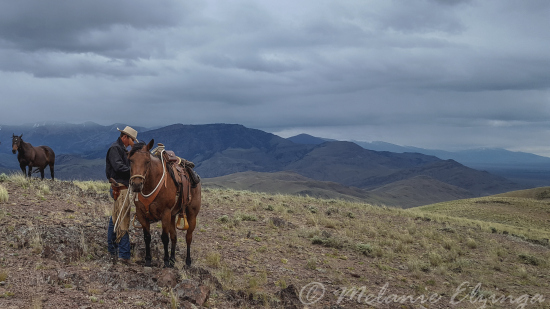
“‹”‹”‹”‹”‹”‹”‹It was typical weather in the high Rockies. Days usually dawned window-pane clear, but by afternoon, the heat drove valley moisture upward to towering 50,000 foot tall thunderheads that yielded lightning and occasional precipitation in these high mountains. I knew perfectly well how much lightning they could bring; in my forest firefighting days, I remember being on call at the Salmon, Idaho Interagency Fire Center during one such “lightning bust.” The cathode-ray tube computer monitor in the dispatch center projected results of the strike activity locator showing over 300 positive strikes in an hour in our county alone. The sky ran crackling hot with static electricity on those August afternoons and evenings, and these days in a 2005 August were no exception.
We rode on up Willow Spring Draw with about 30 cow and calf pairs after a morning sweep through Park Creek Valley that yielded the wayward Angus strays. Our task was to reunite our charges with the rest of the herd in the next drainage of Big Hat Creek.
The bare shoulder of 7000 foot Taylor Butte rose tall between us and our destination. Sooty storm clouds boiled behind that ridge in an ominous and perfectly windless silence. Even the cows showed signs of nervousness as we pressed upward; apparently they had some of the same intuition about their environment in their ancient cow cortex as we did.
There were three of us humans on our stray gather: Mark, aboard Gus, the stiff-trotting, long-legged buckskin quarter horse; Tim, aboard April, the cantankerous and gritty Morgan/Arabian cross; and me, with the seasoned Morgan mare, Missy. Of course, we had two border collies in our ground troop contingent: experienced veteran Arrow, and her protégé, Gypsy-Dave.
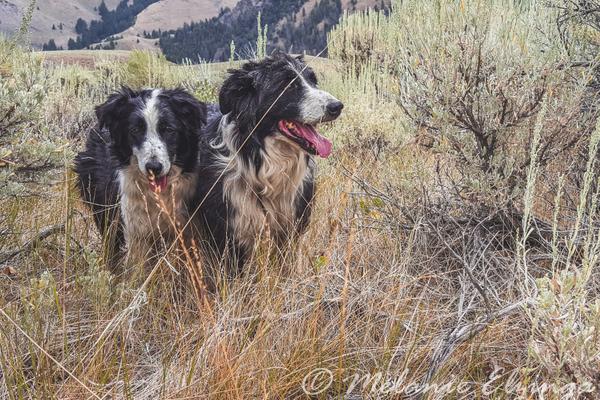
A hot afternoon sun bore down on our backs as we rose above the long valley of Park Creek. The 90 degree heat drew dripping sweat from horse and rider, and the dogs shaded up when they could under tall sagebrush on our crawl up the mountain. We stopped for a deep draught for horse and cow at the Willow Spring stock tank.
We all forced a smile and an uneasy conversation at the memory of when, a few weeks ago, on a similar hot day I had dipped my canteen directly in the spring box source for the tank and poured the crystal clear and sweet mineral water that bubbled right up out of the ground down my parched throat. As I emptied canteen into my dry bones, instantly rejuvenated and refreshed, the other hands silently stood watching from their elevated position on horseback, above. I lowered the canteen into the spring box for another bubbling fill, and wiped my sweaty mug with shirtsleeve.
It was Tim who spoke first from under the shade of his big straw Stetson. “What do ya suppose that white foggy lookin’ thing is in the spring box, Glenn?”
Daughter Melanie sidled over on her mount and looked down into the 2 foot square, half rotten wooden box set into the ground next to the spring at the base of the willow bush. Its perforated sides caught and filtered the water before entering the pipeline that led to the galvanized tank about 100 yards downhill. “Yeah, Dad. What is it?”
I had seen it while filling my canteen, but didn’t know either. “Looks like some grass roots or tree roots that stick out into the water of the box.” I looked closer. “It looks kind of like a tennis ball with white fuzz on it. I don’t know. Let’s have a look.”
I reached in there with my free hand and scooped it up. The fuzzy look matted down as soon as it was freed from the water. I dropped my canteen when I realized just what I had. It was the quite round and very bloated form of a long dead mouse. I dropped him like a hot tater as I realized the sickening relationship between him and what had just refreshed my parched body.
Cowhand laughter ensued after they saw my disgruntled and embarrassed face. When they came to after their fun fest, I offered lemonade from my lemons, as I attempted to pass my refreshingly full canteen. “Anyone care for a drink? Some of the freshest, most balanced spring water I’ve ever tried. Probably high in calcium.”
No takers.
I never did get sick from those tainted waters, even after drinking the rest of my canteen empty that day, figuring I had nothing to lose”¦or gain. Today, we didn’t stop for a refreshing human drink, except from hot canteens in sweaty saddlebags. I asked Morgan Missy to move out, and started in again on the climb. It wasn’t far now, and we would be at the ridge. I hoped we could beat the impending storm.
“‹”‹”‹”‹”‹”‹”‹Mark, Tim, and I reached the ridge, and the Big Hat Country spread out in front of us. A hot wind was picking up now, as we saw the ugly blackened dominance of a massive thunderhead reaching above the far side of Big Hat to the stratosphere. We stood for several minutes, transfixed by lightning and accompanying distant thunder. The cows knew their place, now that we had summited the ridge, and picked their way down off the ridge into the timber, only a quarter mile away. They would find their own way back to their herdmates in the valley far below.
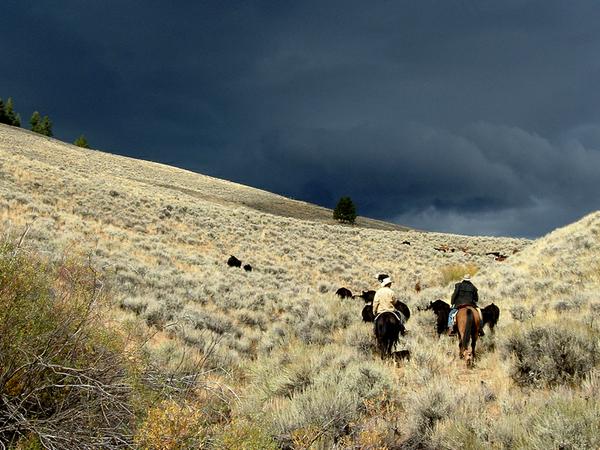
“I think it’s going east, and should skirt by us,” I said. Indeed, we could see the storm cell moving; it seemed to be going toward Sheephorn Fire Lookout, on a prominent peak to the east. “I think we could continue across the other side of Taylor Butte and be OK—I was hoping to look down some of those connecting draws for more strays.”
Mark and Tim nodded agreement, and we leaned forward as we loped across the high grassland that covered the windswept ridge, now waving like the ocean in a seabreeze. We spilled over the next saddle in the ridgeline, and picked up the elk trail that would lead us around just below the 10,000 foot high prominence of the Butte. The thing I didn’t think of was that we wouldn’t be able to watch the track of the massive storm cell from this side, and there was no shelter, not even a tree, for miles on the open grassland side of the steep faced Taylor Butte.
Despite its narrowness, the trail that centuries of elk and bison had worn into the sidehill of the mountain was pounded pretty smooth, and we were able to line out our steeds and trot. We skipped into the first big draw, and soon broke out on the first buttress ridge where we were met by more wind. It stopped us in our tracks. It was a frigid wind in stark contrast to what we’d experienced on the first ridge. We all knew where it came from: straight down from around 35,000 feet elevation in the middle of that terrific thunderhead. We all knew my storm track forecast was wrong if we were getting icy downdrafts. We were in the path. And completely exposed to lightning strike as one of the tallest things on the ridge.
I looked at the boys. “We better move out hard. We could be in a world of hurt if we don’t get outta here.” It didn’t take any coaxing to move our mounts; they knew likely better than we with their even sharper intuition that things could go wrong.
The wind picked up, and with it, a blinding flash, and a near immediate blast of thunder. We were loping now, and it was all I could do to keep Missy out of a dead run gallop. It was far too dangerous to go wide open on the steep mountainside where a misstep on the rock strewn trail could send horse and rider in an endless fatal tumble of a quarter mile. In most places, the mountainside was too steep and the trail’s 2 foot width far too narrow to even turn around safely. Flashes and a near immediate response of deafening peals of thunder came hot and heavy. I thought I felt my my scalp starting to tingle- a bad sign of electrical charge buildup.
Then the rain came, thick heavy drops that soaked our single layer shirts in less than a minute, and now we were forced to hold our terror-stricken horses to a controlled trot in the slick mud that coated the trail. It was all we could do to hold them back.
As we made our way around the side of the mountain, I could finally make out the outline of the final ridge that marked the roll of the Butte to its north face, a steep hillside covered with dense stands of old growth Douglas-fir. Straining eyes, I noted the sawtooth silhouettes of trees in the dim light under black sky and heavy rain. Thinking that the understory could be a likely refuge from the tempest of wind and driving rain. I turned to my now freezing comrades as we continued the controlled trot across the steep face of the mountain, and their faces were lit with the reflection of blinding white when a bolt blew into a tree on the skyline.
I recalled that a few years prior in the next valley where a friend of mine lost 12 cows when the lone tree they sought protection under took a direct lightning strike and instantly killed the cattle beneath. Maybe the forest refuge was a bad idea.
We stopped to yell out our options while our mounts pawed the ground nervously, wanting to move on. “Would it be safer in the timber?” I yelled.
“Once we got into the thick of it,” yelled back Mark. “If we could get away from the edge–that seems to be where most of the lightning is hitting!”
We stood for another minute, loudly considering our options. Finally, our mind was made up by a new complicating factor.
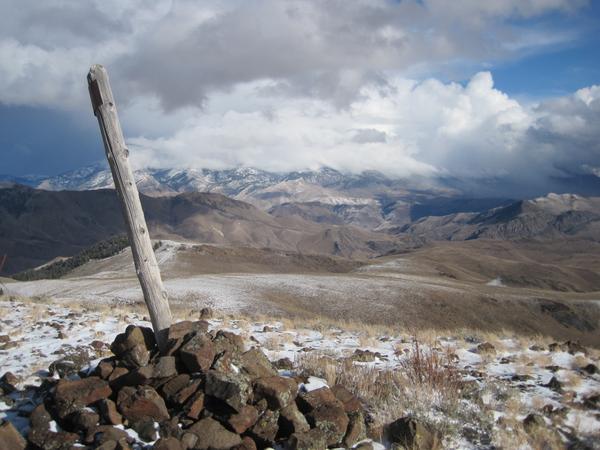
The heavy rain became hail. It started as a mix, but in another minute, it was full on hail. Hailstones the size of marbles pelted us relentlessly—some were nearly ping pong ball sized. Our horses started nervously, fearfully crowhopping under the relentless smarting of ice balls coming in at terminal velocity. Our shirts gave us little protection; I was grateful for the cowboy hat we each wore. If we didn’t move now, our mounts would probably buck us off and find their own luck.
We took off for the trees despite the nearly continuous pounding of lightning. It was like a battlefield, and at any moment static electricity could decide that our cowboy hats were the highest point along the ridge we rode. After several breakneck minutes we were there, and launched into the thick conifer forest, picking our way through slippery and ice covered log downfalls for cover from the relentless pelting by falling ice from the sky.
We pulled up and dismounted under a thick grove in the dark forest about a hundred yards from the ridge. Thankfully, the border pups, beaten and soaked showed up right behind us. I had forgotten about them. They dug in along tree trunks into the thick, dry duff, finally finding rest from the storm that continued to rage overhead. Flashes of light and thunder rolled and reverberated over us.
The horses gladly stood, now finally calming despite still blowing hard in the shelter of the dense conifers. I could see where all animal life could find solace from storm under the thick fir canopy. Only a few drips found their way down through the big trees, and the hailstones were shed by the sloping dense branches.
But there was more to deal with than just the storm.
Gypsy-Dave and Arrow, the border pups, started whining and yipping, biting themselves as they came over to me from their pine duff dog beds. A strange cloud followed them in the dim light and as they approached, I recognized it as a swarm of yellowjackets around the two dogs. The horses started bucking in the sudden stinging storm following the dogs, and we humans started swatting yellowjackets off us and the crying dogs. We fled to another grove, finally outrunning the hornets and I spent the next 15 minutes pulling the little beasts still clinging to the dog’s thick hair coats.
The hail transitioned back to rain as the storm cell passed over us. We sighed with relief that it was over. It had rained enough that any lightning caused fires were not a concern, and we smelled no smoke despite the myriad strikes along the edge of the timbered summit ridge of Taylor Butte.
“‹”‹”‹”‹”‹”‹”‹As the rain abated, we saddled up, checked gear, and slowly picked our way across the steep slope through the downed wood and trees typical of old-growth forest. We took new interest in spotting old lightning strikes scars on the bigger fir trees on the way down, evidence that this story was a repeat on Taylor Butte. Lightning did strike the same places twice. Maybe even thrice on this hillside. It was a long ride to the trailer and home, and horses, human and dogs were grateful when, in the gathering darkness, we spotted our humble robin-egg blue stock trailer that would take us over the bumpy two track back to the ranch.
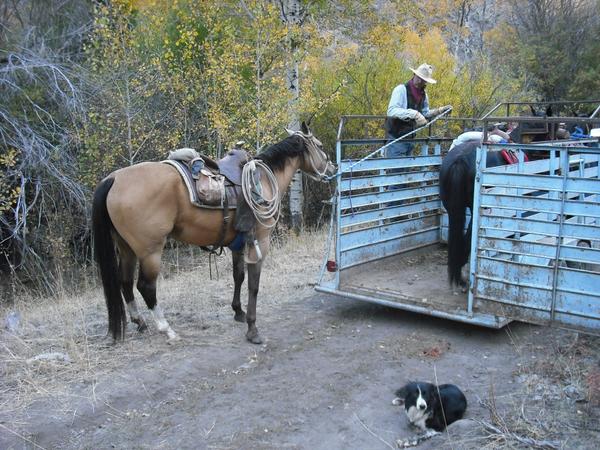
From my office window on this January day, I can see the broad expanse of our 70 square mile summer ranges. In the window pane clear air of this zero degree day under azure skies, I can identify individual fir trees on the open mountainsides nearly 20 miles away. I know many of those specific trees and rocks as if by name in the mental map that my mind has created while riding over that landscape in all kinds of weather. It’s a map that continues to get pieced together through hours on horseback as we pasture and herd summer cattle on that piece of the Rocky Mountain wilderness we call simply “the range.”
The difference between my map and that on Google Earth is that mine is alive with story: stories of horses and hailstorms and of border collies and bears, and of people too, stories of large herds of elk that share grass with our cattle, and where snows fall in summer, stories of wolves howling under the moon and eagles swooping overhead. All of these are stories of place where we live and run beeves in what is de-facto wilderness, rarely visited by other humans.
And we continue to learn. There’s no textbook or webinar on how to raise beeves in such wild settings. We can only learn from the land and the animals on it. Usually, they are patient teachers for humans that don’t always listen. But sometimes, nature takes out the big stick and makes us wise up. Thankfully, close calls are all we’ve had, other than some broken bones and concussions. But the close calls often teach us lessons and perspective in this place where we are only temporary residents.
It takes a lifetime to begin to learn such a place. I feel blessed to spend my time learning it. And I believe the wild landscape yields flavor and wellness that I can be proud to share with you, our customers and partners. Intact wilderness pristine soils mean an uncompromised (and quite incomparable) living matrix of nutrients available to plants and the beeves that consume them. And that nutrition they take in creates the flavor that I think resonates with the ancient intuitions that still are an undeniable part of our DNA.
Thanks for being a part of this, of contributing to our opportunity to caretake and steward these nearly 50,000 acres of wild mountain grass, as well as the meadows and pastures on our valley ranch. It is a responsibility we don’t take lightly, and are honored to have you along on this journey.
Happy trails.
Glenn, Caryl, Girls and Cowboys at Alderspring



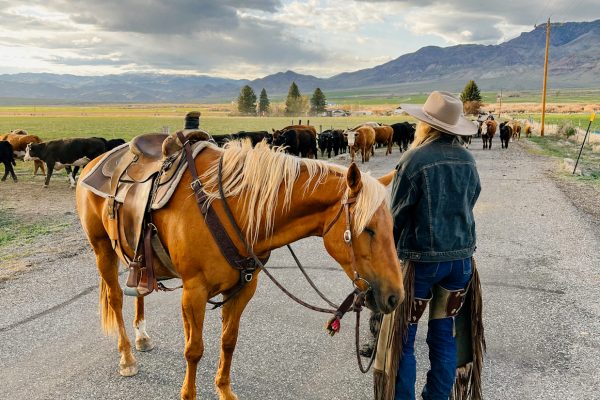
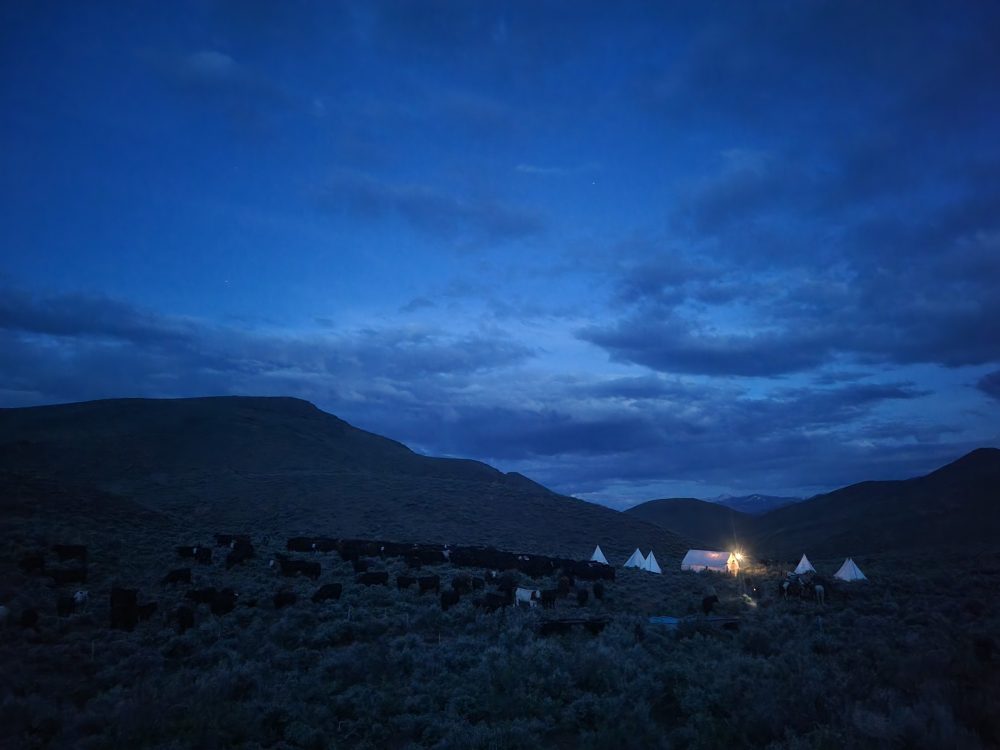
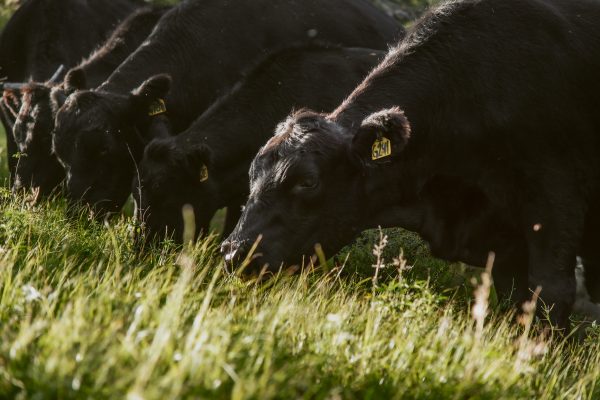
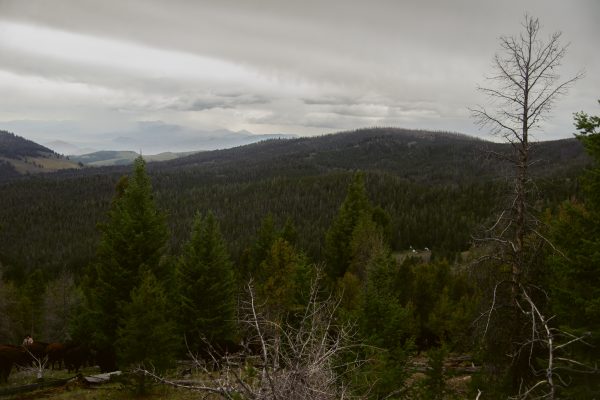
Deb Olsen
In the ever changing climate and weather you’ve learned so many wonderful and mysterious things about being one with nature and syncing with it. You definitely have your inner instincts on high alert sometimes and I truly enjoy being part of your journeys by reading and envisioning your words. By the way, how about some refreshing rat water ha ha. That was pretty funny, I’m glad you didn’t have any ill effects. 😊